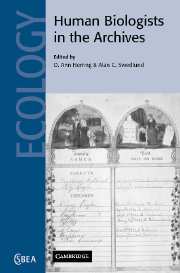 Human Biologists in the Archives
Human Biologists in the Archives Book contents
- Frontmatter
- Contents
- Contributors
- Foreword by Sydel Silverman and Michael A. Little
- Acknowledgements
- 1 Human biologists in the archives: demography, health, nutrition and genetics in historical populations
- 2 The use of archives in the study of microevolution: changing demography and epidemiology in Escazú, Costa Rica
- 3 Anthropometric data and population history
- 4 For everything there is a season: Chumash Indian births, marriages, and deaths at the Alta California missions
- 5 Children of the poor: infant mortality in the Erie County Almshouse during the mid nineteenth century
- 6 Worked to the bone: the biomechanical consequences of ‘labor therapy’ at a nineteenth century asylum
- 7 Monitored growth: anthropometrics and health history records at a private New England middle school, 1935–1960
- 8 Scarlet fever epidemics of the nineteenth century: a case of evolved pathogenic virulence?
- 9 The ecology of a health crisis: Gibraltar and the 1865 cholera epidemic
- 10 War and population composition in Åland, Finland
- 11 Infectious diseases in the historical archives: a modeling approach
- 12 Where were the women?
- 13 Malnutrition among northern peoples of Canada in the 1940s: an ecological and economic disaster
- 14 Archival research in physical anthropology
- Index
- References
3 - Anthropometric data and population history
Published online by Cambridge University Press: 12 August 2009
- Frontmatter
- Contents
- Contributors
- Foreword by Sydel Silverman and Michael A. Little
- Acknowledgements
- 1 Human biologists in the archives: demography, health, nutrition and genetics in historical populations
- 2 The use of archives in the study of microevolution: changing demography and epidemiology in Escazú, Costa Rica
- 3 Anthropometric data and population history
- 4 For everything there is a season: Chumash Indian births, marriages, and deaths at the Alta California missions
- 5 Children of the poor: infant mortality in the Erie County Almshouse during the mid nineteenth century
- 6 Worked to the bone: the biomechanical consequences of ‘labor therapy’ at a nineteenth century asylum
- 7 Monitored growth: anthropometrics and health history records at a private New England middle school, 1935–1960
- 8 Scarlet fever epidemics of the nineteenth century: a case of evolved pathogenic virulence?
- 9 The ecology of a health crisis: Gibraltar and the 1865 cholera epidemic
- 10 War and population composition in Åland, Finland
- 11 Infectious diseases in the historical archives: a modeling approach
- 12 Where were the women?
- 13 Malnutrition among northern peoples of Canada in the 1940s: an ecological and economic disaster
- 14 Archival research in physical anthropology
- Index
- References
Summary
Introduction
This paper deals with the use of anthropometric data in reconstructing the history of human populations. Anthropometric measures of the body and head have been collected on many populations over the past few centuries. Although data collection and analysis were frequently done within the outdated context of racial classification, new models and methods allow us to revisit anthropometric variation from the perspective of current evolutionary theory. In these days of rapidly developing means of directly assessing DNA variation, anthropometric data are often likely to be seen as old-fashioned. However, despite their antiquity, anthropometric data still have a lot to offer us in terms of insight into population structure and history. The purpose of this paper is two-fold: (1) to describe in general terms the use of anthropometric data in the study of population history, and (2) to present summaries of two case studies using anthropometric data from Ireland. In both cases, the results show the clear influence of historical events relating to differential immigration on the pattern of biological variation within Ireland.
What do anthropometric data have to do with the focus of this volume – archival data? Many anthropometric data are historical, in the sense of having been recorded at an earlier time. Some measurements, notably height and weight, were routinely recorded in the past, particularly in military records. More comprehensive anthropometric data collections, including other measures of the body and head, stem from the nineteenth and twentieth centuries, and sometimes earlier.
- Type
- Chapter
- Information
- Human Biologists in the ArchivesDemography, Health, Nutrition and Genetics in Historical Populations, pp. 32 - 52Publisher: Cambridge University PressPrint publication year: 2002


